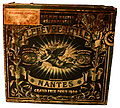Lefèvre-Utile

Lefèvre Utile , better known under the abbreviation LU , is the name of a French food company that was founded in Nantes in 1846 and has been part of Kraft Foods / Mondelēz International since 2007 .
history
Jean-Romain Lefèvre opened a small confectionery bakery in Nantes in 1846 at 5 rue Boileau. The success of his biscuits made the small company famous. The marriage with the enterprising Pauline-Isabelle Utile led to the name being changed to Pâtisserie Lefèvre Utile . In 1854, the company was enlarged for the first time and the sales point was designed in an architecturally luxurious manner, with particular attention to hygiene when selling.
In 1882, Louis Lefèvre-Utile (1858–1940), the son of the company's founder, who died early, took over management of the company and developed it into a large-scale mechanized operation. In 1885 he built a biscuit factory with a steam engine on Quai Baco. 130 workers could be employed there on 2000 square meters. Soon the Petit-Beurre shortbread , created in 1886, made up two thirds of production. The entrepreneur based himself on British models such as T. & T. Vicars. A major fire on May 4, 1888 did not affect the company's rise.
Louis Lefèvre-Utile attached great importance to efficient advertising: Current political events such as state visits, Louis Blériot's canal flight, etc. found their echo in special products. At the World Exhibition in Paris in 1900 , the widely visible LU pavilion with its 36 meter high lighthouse, the work of the architect Auguste Bluysen, caused a sensation . The top of the tower was designed after one of the LU biscuit jars customary at the time. The architect designed the two twin towers of the factory in a similar way.
Even after the First World War , the biscuit factory remained a family business. Louis Lefèvre-Utile protested, however, in vain against the filling in of the arm of the Loire in front of his artistically demanding factory and the use of the site by the railroad. As a result, his son Michel Lefèvre-Utile increasingly took on management tasks. His son and successor Patrick Lefèvre-Utile decided to devote himself to the export business, but soon found himself forced to enter into alliances in the highly competitive market.
In 1968, six companies in the branch merged under the name LU-Brun & Associés. Patrick Lefèvre-Utile became the president of this group of companies, but over time the family lost its determining influence on LU. Cross-border mergers took place in quick succession. Générale Biscuit , listed on the stock exchange from 1978, was a conglomerate of 32 companies and held third place in the industry behind Nabisco and United Biscuits . In 1986, Générale Biscuit built a new, ultra-modern factory in La Haie-Fouassière . The factory in Nantes was obsolete in 1989. Turbulent years followed under the dominance of Danone and finally the purchase by the American group Kraft Foods / Mondelēz International .
The rather patriarchal tradition of the former family business was replaced by a sharp focus on maximum efficiency, which also led to social tensions.
Cultural meaning
Among the artists who worked for LU were Alfons Mucha , Firmin Bouisset , Capiello , Luigi Loir and, more recently, Folon , Desclozeaux , Raymond Savignac . The plant, which is centrally located near the castle, was once a symbol of Nantes . This architectural ensemble is largely destroyed today.
Manufacture Biscuits "LU": Vue prize en ballon ("LU biscuit factory: view from the balloon") advertisement in L'Illustration , 1924
Alfons Mucha , advertising poster 1896.
Wall advertisement for LU in Trentemoult
literature
- Jean-Louis Kerouanton: LU: une usine à Nantes. Nantes 1999, ISBN 2-906344-70-3 .
- Didier Sutter: Victoria. Biscuits chocolate. De la manufacture aux géants de l'agroalimentaire. Drukker, Paris 2008, ISBN 978-2-9531043-0-1 .










